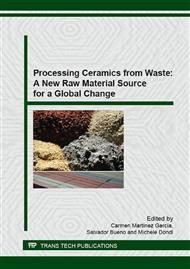[1]
L. Zhang. Production of bricks from waste materials – A review. Construction and Building Materials 47 (2013) 643-655.
DOI: 10.1016/j.conbuildmat.2013.05.043
Google Scholar
[2]
S.P. Raut. R.V. Ralegaonklar. S.A. Mandavgane. Development of sustainable construction material using industrial and agricultural solid waste: A review of waste-create bricks. Construction and Building Materials 25 (2011) 4037-4042.
DOI: 10.1016/j.conbuildmat.2011.04.038
Google Scholar
[3]
D. Eliche-Quesada. C. Martínez-García. M.L. Martínez-Cartas. M.T. Cotes-Palomino. L. Pérez-Villrejo. N. Cruz-Pérez. F.A. Corpas-Iglesias. The use of different forms of waste in the manufacture of ceramic bricks. Applied Clay Science 52 (2011).
DOI: 10.1016/j.clay.2011.03.003
Google Scholar
[4]
J.A. Cusidó. C. Soriano. Valorizaton of pellets from municipal WWTP sludge in lightweight ceramics. Waste Management 31 (2011) 1372-1380.
DOI: 10.1016/j.wasman.2011.02.003
Google Scholar
[5]
Y. Qi. Q. Yue. S. Han. M. Yue. B. Gao. H. Yu. T. Shao. Preparation and mechanism of ultra-lightweight ceramics produced from sewage sludge. Journal of Hazardous Materials 176 (2010) 76-84.
DOI: 10.1016/j.jhazmat.2009.11.001
Google Scholar
[6]
S. Raut. R. Ralegaonkar. S. Mandavgane. Utilization of recycle paper mill residue and rice husk ash in production of light weight bricks. Archives of Civil and Mechanical Engineering 13 (2013) 269-275.
DOI: 10.1016/j.acme.2012.12.006
Google Scholar
[7]
L. Barbieri. F. Andreola. I. Lancellotti. R. Taurino. Management of agricultural biomass wastes: Preliminary study on characterization and valorisation in clay matrix bricks. Waste Management. 11 (2013) 2307-2315.
DOI: 10.1016/j.wasman.2013.03.014
Google Scholar
[8]
I. Demir. M. Serhat Baspinar. M. Orhan. Utilization of kraft pulp production residues in clay brick production. Building and Environment 40 (2005) 1533-1537.
DOI: 10.1016/j.buildenv.2004.11.021
Google Scholar
[9]
M. Sutcu. S. Akkurt. The use of recycled paper processing residues in making porous brick with reduced thermal conductivity. Ceramics International 35 (2009) 2625-2631.
DOI: 10.1016/j.ceramint.2009.02.027
Google Scholar
[10]
P. Muñoz. M.C. Juárez. M.P. Morales. M.A. Mendívil. Improving the thermal transmittance of single-brick walls built of clay bricks lightened with paper pulp. Energy and Buildings 59 (2013) 171-180.
DOI: 10.1016/j.enbuild.2012.12.022
Google Scholar
[11]
H. Bal. Y Jannot. S. Gaye. F. Demeurie. Measurement and modelisation of the thermal conductivity of a wet composite medium: laterite based bricks with millet waste additive. Construction and Building Materials 41 (2013) 586-593.
DOI: 10.1016/j.conbuildmat.2012.12.032
Google Scholar
[12]
G. Görhan. O. Simsek. Porous clay bricks manufactured with rice husks. Construction and Building Materials 40 (2013) 390-396.
DOI: 10.1016/j.conbuildmat.2012.09.110
Google Scholar
[13]
J. García-Ten. M.J. Orts. A. Saburit. G. Silva. Thermal conductivity of traditional ceramics. Part II: Influence of mineralogical composition. Ceramics International 36 (2010) 2017-(2024).
DOI: 10.1016/j.ceramint.2010.05.013
Google Scholar
[14]
D. Betancourt. F. Martirena. R. Day. Y. Díaz. The influence of the addition of calcium carbonate on the energy efficiency of fired clay bricks manufacture. Revista Ingeniería de Construcción 22 (2007) 187-196.
Google Scholar
[15]
M.F. Serra. M.F. Acebedo. M.S. Conconi. G. Suarez. E.F. Aglietti. N.M. Rendtorff. Thermal evolution of the mechanical properties of calcareous earthware. Ceramics International 40 (2014) 1709-1716.
DOI: 10.1016/j.ceramint.2013.07.067
Google Scholar
[16]
F. Saboya Jr. G.C. Xavier. J. Alexandre. The use of the powder marble by-product to enhance the properties of brick ceramic. Construction and Building Materials 21 (2007) 1950-(1960).
DOI: 10.1016/j.conbuildmat.2006.05.029
Google Scholar
[17]
R. Sokolár. L. Vodová. S. Grygarová. I. Stubna. P. Sin. Mechanical properties of ceramic bodies based on calcite waste. Ceramics International 38 (2012) 6607-6612.
DOI: 10.1016/j.ceramint.2012.05.046
Google Scholar
[18]
R.J. Galán-Arboledas. A. Merino. S. Bueno. Use of new raw materials and industrial wastes to improve the possibilities of using ceramic materials from Bailén (Jaén. southern Spain). Materiales de Construcción. 63 (2013) 553-568.
DOI: 10.3989/mc.2012.03412
Google Scholar
[19]
A. Barba, V. Beltrán, C. Feliu, J. García, F. Ginés, E. Sánchez, V. Sanz, Acción del calor sobre las materias pirmas, in: Materias primas para la fabricación de soportes de baldosas cerámicas, Instituto de Tecnología Cerámica, Castellón, 2002, pp.159-194.
DOI: 10.3989/mc.1972.v22.i146.1426
Google Scholar
[20]
L. Sánchez Muñoz, J.B. Carda Castelló, Transformaciones con la temperatura, in: Materias primas y aditivos cerámicos. Enciclopedia Cerámica. Tomo 2. 2, Faenza Editrice Ibérica S.L., Castellón, 2003, pp.88-120.
Google Scholar


